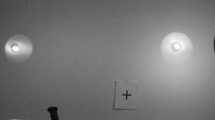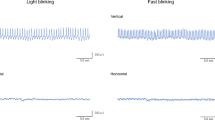Abstract
Purpose
To determine whether there is a change in the pattern of human eyeblink events under topical ocular anaesthesia.
Methods
Forty male subjects, aged between 19 and 52 years and with no significant ocular surface disease, were recruited. Their spontaneous eyeblink activity, in primary eye gaze position and in silence, was recorded for 5-min periods, before and after instillation of benoxinate 0.4% eyedrops. The surface anaesthesia was confirmed by aesthesiometry.
Results
The spontaneous eyeblink rate (SEBR) decreased from 9.1±4.0 blinks/min to an average of 5.7±3.3 blinks/min, with 37 subjects showing a decreased eyeblink rate under anaesthesia. Three blink patterns were observed before anaesthesia (symmetrical, J-type and I-type) and these were essentially unchanged under anaesthesia.
Conclusions
These studies confirm that the SEBR is usually reduced under surface anaesthesia (so is sensitive to exogenous control) but the pattern of the eyeblink activity is unchanged (so is less sensitive to exogenous control). The removal of exogenous stimuli by anaesthesia does not shift the eyeblink pattern to a single type, so indicates endogenous control.





Similar content being viewed by others
References
Carney LG, Hill RM (1982) The nature of normal blinking patterns. Acta Ophthalmol 60:427–433
Collins M, Seeto R, Campbell L, Ross M (1989) Blinking and corneal sensitivity. Acta Ophthalmol 67:525–531
Davson H (1972) The protective mechanisms. In: Davson H (ed) The physiology of the eye, 3rd edn. Churchill Livingstone, Edinburgh, p 416
Doughty MJ (2001) In consideration of three types of spontaneous eyeblink activity in normal humans—during reading and video display terminal use, in primary gaze and while in conversation. Optom Vis Sci 78:712–725
Doughty MJ (2002) Further assessment of gender-and blink pattern-related differences in the spontaneous eyeblink activity in primary gaze in young adult humans. Optom Vis Sci 79:439–447
Doughty MJ, Blades K, Ibrahim N (2002) Assessment of the number of eye symptoms, and the impact of some confounding variables, for office staff in non-air conditioned buildings. Ophthalmic Physiol Opt 22:143–155
Dudinski O, Finnin BC, Reed BL (1983) Acceptability of thickened eyedrops to human subjects. Curr Ther Res 33:322–337
Freudenthaler N, Neuf H, Kadner G, Schlote T (2003) Characteristics of spontaneous eyeblink activity during video display terminal use in healthy volunteers. Graefes Arch Clin Exp Ophthalmol 241:914–920
Huber P (1962) Untersuchungen über die Beeinflussung des spontanen Lidschlages durch Lokal-Anaesthetica. V. Graefes Arch Ophthalmol 164:594–611
Karson CN (1988) Physiology of normal and abnormal blinking. Adv Neurol 49:25–37
Lawrenson JG, Ruskell GL (1993) Investigation of limbal touch sensitivity using a Cochet–Bonnet aesthesiometer. Br J Ophthalmol 77:339–343
Nakamori K, Odawara M, Nakajima T, Mizutani T, Tsubota K (1997) Blinking is controlled primarily by ocular surface conditions. Am J Ophthalmol 124:24–30
Ponder E, Kennedy WP (1927) On the act of blinking. Q J Exp Physiol 18:89–110
Stancák A, Fabián Z, Dostalek C (1993) Spectral analysis of inter-eyeblink interval variability at rest and during mental arithmetic. Homeostasis 34:4553
Stern JA, Walrath LC, Goldstein R (1984) The endogenous eyeblink. Psychobiology 21:22–33
Tsubota K (1998) Tear dynamics and dry eye. Prog Retin Eye Res 17:565–596
Tsubota K, Hata S, Okusawa Y, Egami F, Ohtsuki T, Nakamori K (1996) Quantitative videographic analysis of blinking in normal subjects and patients with dry eye. Arch Ophthalmol 114:715–720
Zaman ML, Doughty MJ (1997) Some methodological issues in the assessment of the spontaneous eyeblink frequency in man. Ophthalmic Physiol Opt 17:421–432
Zaman ML, Doughty MJ, Button NF (1998) The exposed ocular surface and its relationship to spontaneous eyeblink rate in elderly Caucasians. Exp Eye Res 67:681–686
Acknowledgements
We should like to thank Dr Mohammed Laiquzzaman, James Duff and David Bullions for assistance in the early stages of this study.
Author information
Authors and Affiliations
Corresponding author
Rights and permissions
About this article
Cite this article
Naase, T., Doughty, M.J. & Button, N.F. An assessment of the pattern of spontaneous eyeblink activity under the influence of topical ocular anaesthesia. Graefe's Arch Clin Exp Ophthalmol 243, 306–312 (2005). https://doi.org/10.1007/s00417-004-0990-z
Received:
Revised:
Accepted:
Published:
Issue Date:
DOI: https://doi.org/10.1007/s00417-004-0990-z




